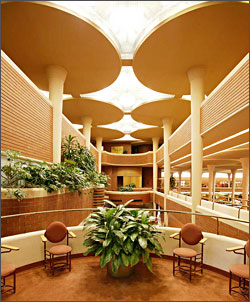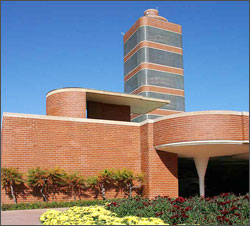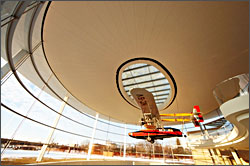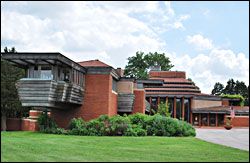Wright in Racine
In southeast Wisconsin, a wax magnate's decision to hire 'the greatest architect in the world' had stunning results.

© SC Johnson
Wherever he worked, Frank Lloyd Wright was good for a story.
In Racine, Wis., the staff of global manufacturer SC Johnson has plenty of them to tell.
In 1936, the grandson of the company's founder hired the flamboyant architect to design an Administration Building. "Don't make it too unconventional," H.F. Johnson Jr. told Wright.
So Wright designed a half-acre room with a roof of glass tubing, held up by concrete flying saucers on spindly legs.
Johnson loved it. So in 1950, Wright gave him a cantilevered Research Tower, with alternating round and square floors.
Today, hundreds of people join free tours of the complex each week, trooping through buildings that seem as futuristic today as when they opened.
A Wright pilgrimage
Wisconsin has created a Frank Lloyd Wright Heritage Trail, with signs that direct architecture fans from Racine to Madison and from Spring Green to Richland Center, Wright's birthplace.
On a cross-state architecture pilgrimage, Racine makes a spectacular first stop.
I joined one of the Wright tours in the Golden Rondelle theater, a gleaming gold pod that H.F. Johnson Jr. commissioned as the company pavilion at the 1964-65 World's Fair.
From there, guide Emily Brzezinski led us past reflecting ponds to the Administration Building, which we entered through a low carport held up by the dendriform columns that, inside, soar to 31 feet.
"Wright always wanted to make a dramatic entrance," she remarked.
Working with a genius
The strong-willed Wright lost his first fight with his client. He wanted to put the company headquarters in the bucolic countryside outside Racine, and Johnson wanted it in an industrial area near Lake Michigan.
Wright didn't think workers should have to see that view. So instead of using windows, he flooded the Great Workroom with light from 43 miles of glass tubing on the ceiling.
The second fight, Wright won. When safety inspectors questioned his plan to support 12 tons of ceiling with a column that had a 9-inch base, he put a sample column in a parking lot and heaped it with rocks and rubble — more and more until a crack finally appeared at 30 tons.

© SC Johnson
When the rubble was dumped off, it broke a water main 10 feet below ground level.
Wright's Great Room is warm with natural light and his favorite color, Cherokee red, found in the brick, rubber flooring, upholstery and metal of desks and chairs.
Wright designed the furniture, too, including an elegant, three-legged swivel chair that had a nasty habit of dumping workers who crossed their legs. He told the workers to get used to it — until he, too, tipped over. Then he designed a four-legged chair.
It took days to change a lightbulb in the tube ceiling, which, of course, leaked. So did the roof at Wingspread, the residence on the north edge of Racine that Wright designed for Johnson at the same time.
When H.F. Johnson called Wright during a dinner party to complain that rain was dripping on his head, Wright famously replied, "Well, Hib, why don't you move your chair?"
I asked Brzezinski if H.F. Johnson ever got tired of dealing with Wright, and she smiled.
"I think they had a kind of father-son relationship," she said. "H.F.'s father died when he was a young man, and Wright was his father's age."
Our next stop was the slender, 15-story Research Tower, supported by a central core sunk deep into the ground and wrapped with a shell of glass tubing.
It was horribly drafty and swayed in stiff winds off the lake. The scientists often had to wear sunglasses and couldn't see each other around the 13-foot central column. But between 1950 and 1960, they developed the familiar products Raid, Glade, Pledge and Off!
Today, the building is a time capsule just for visitors, with two floors of work spaces covered with vintage test tubes, photos, products and advertising.
In 1982, safety regulators shut the Research Tower down: Only an elevator and a narrow spiral staircase provided exits to a building that was full of chemicals and used for open-flame experiments.
Our next stop was Fortaleza Hall, designed by Foster+Partners in 2010 and named for the city in Brazil that H.F. Johnson visited in 1935, procuring a crucial supply of wax from the leaves of the carnauba palm.
From the hall's glass atrium hangs a replica of the amphibian plane that Johnson's son Sam used in 1998 to retrace the 1935 expedition, which his father said "changed my life." Images of palm trees are etched onto walls, and a wood mosaic of the route is laid into the well-waxed floor.

© SC Johnson
H.F. Johnson Jr. was a bold adventurer who thought big. You had to be to run a global business, and you had to be to hire Mr. Frank Lloyd Wright.
Trip Tips: Racine and Frank Lloyd Wright
Getting there: Racine is half an hour south of Milwaukee and about an hour north of Chicago. The SC Johnson complex is right off Wisconsin 32 on the south edge of downtown.
Tours: The 90-minute Wright Tour of the 1939 Administration Building and 1950 Research Tower is offered from April through December.
Both are on the National Register of Historic Places. Some tours include a visit to H.F. Johnson Jr.'s 1940s penthouse office.
Tours also include 2010 Fortaleza Hall, which contains the SC Johnson Gallery, including the exhibit "At Home With Frank Lloyd Wright," as well as the Lily Pad gift shop and Timeline Tunnel history exhibit, which traces company history through five generations of Johnsons, from its founding in 1886 to the present.
Reserve tours in advance.

© Real Racine
The theater also shows two films, the one-hour "Carnauba: A Son's Memoir" and the 20-minute "To Be Alive!" which SC Johnson commissioned for the World's Fair. Reservations are required.
SC Johnson also offers a free, one-hour tour of Wingspread, which Wright called the "last of the Prairie houses." The architect designed it for H.F. Johnson Jr. and his family and completed it in 1939.
The 14,000-square-foot house has four wings and is a National Historic Landmark. It's five miles north on Four Mile Road, near Wind Point Lighthouse.
More about Wright and the Johnsons: According to a New York Times story published upon the reopening of the Research Tower in 2014, current CEO Herbert Fisk Johnson III said Wright and his grandfather did indeed have a "love-hate" relationship.
Though H.F. Jr protested that the Administration Building had been a "financial and construction nightmare" — it cost nearly half the net worth of the entire company — he acquiesced to Wright's plans for the Research Tower, which now is one of only two remaining Wright high-rises.
More Racine attractions: Visit North Beach, the Racine Zoo, the Racine Art Museum or, on a warm day, downtown's Pershing Park, where there's a splash pad.
On the north end of town, the 1880 Wind Point Lighthouse is a classic Poe tower that's one of the tallest on the Great Lakes. On the first Sunday of the month from June through October, you can tour it.
Information: Racine tourism, 262-884-6400.